Abstract
Ballota acetabulosa (L.) Benth. (syn. Pseudodictamnus acetabulosus (L.) Salmaki and Siadati), f. Lamiaceae, the Greek horehound, is a compact evergreen small shrub native to Greece, with hairy grey-green leaves, that bears small pink-purple flowers with green conical calyxes along its erect stems in late spring. The species stands out for its high resistance in xerothermic conditions and therefore it is advisable to promote its use in xeriscaping. The aim of this study was to develop an efficient protocol for in vitro propagation of B. acetabulosa for introduction into the horticultural and pharmaceutical industries. Shoot tip and single node explants derived from in vitro seedlings were cultured on MS medium with various cytokinin types and concentrations. Explants responded at almost 100% to produce high number of shoots on a medium with 1.0 mg L−1 zeatin or 6-benzyladenine. However, there was intense hyperhydricity in the cultures, which was addressed in further experiments by increasing agar concentration from 8 to 12 g L−1, preserving high multiplication indices (92% response, 10.2 shoots per explant). Microcuttings with 2–3 visible nodes, either from the apical part, including the apical meristem, or from the basal part of microshoots, as well as microshoot clusters, rooted 100% on full- or half-strength MS medium, respectively, regardless of the addition of indole-3-butyric acid (ΙΒA, 0.5–4.0 mg L−1) in the rooting medium. However, middle level concentrations of IBA increased the number and length of roots produced, while the higher its concentration, the more and longer axillary shoots developed in the microcuttings during the rooting period. The acclimatization of all plantlets was completely successful (100%) in ex vitro conditions on peat/perlite substrate (1:1, v/v). Thus, efficient methods of producing propagation material to promote Ballota acetabulosa as a horticultural and medicinal plant were developed. In particular, rooting of microshoot clusters or microcuttings without the shoot tip, in the presence of 1.0 mg L−1 IBA, leads to a plant of suitable shape for the floricultural market, without the need for further manipulation (pruning) in the nursery.
1. Introduction
Ballota acetabulosa (L.) Benth., syn. Pseudodictamnus acetabulosus (L.) Salmaki and Siadati (f. Lamiaceae), the Greek horehound, is a compact, bushy, evergreen xerophyte, 30–60 cm height, being one of the most widely spread small shrubs all over Greece, especially in the SE, including Crete and other Greek islands, except the area of the Pindos mountain range in the northwest [1]. It is also native in western Turkey [2]. It is found mainly in poor alkaline soils, dry lands, and stony places [3,4,5], but grows equally well in sandy and clay soils. The plant belongs to the group of late-spring/summer-flowering species of Greece [6]; has erect-white-felted stems and paired, ovate, woolly grey-green heart-shaped leaves; and bears small pink-purple flowers with green conical calyxes along the stems in the axils of the leaves. The characteristic epithet of the genus “acetabulosa” comes from the Latin acetabulum = calyx, since the appearance of the plant is characterized by the presence of many dense calyces (Figure 1).
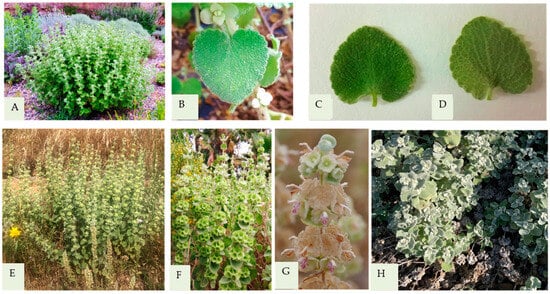
Figure 1.
Ballota acetabulosa young plant in xeriscaping in late March (A), shoot sprouting and leaf (B), upper (C) and lower (D) leaf surface, plant growing wild in Mount Hymettus, Athens (Attika) in May (E), shoots with the dense calyces of the plant in July (F), stem at flowering in late August (G), plant in November where dried shoot inflorescence and new vegetation are showing (H).
Since ancient times, people have used B. acetabulosa for many purposes [7]. The Greek Pedanius Dioscorides (c. 40–90 AD), “the father of pharmacognosy”, describes the plant and its medicinal properties in De materia medica (On Medical Material), a Greek encyclopedia on herbal medicine and related medicinal substances, which was widely read for more than 1500 years. Nowadays, the species retains interest as a medicinal plant, as it has mild astringent and antibacterial properties and is still used for nausea, vomiting, dyspepsia, and as a sedative [8,9,10]. Also, methanol extracts of B. acetabulosa have been reported to possess antioxidant activity [11]. The seed vessels were used by Greek peasants as floating wicks in lamps of olive oil mainly in front of icons, and the plant is therefore sometimes called “louminia”.
The appearance of the plant and its tolerance to barren, dry, alkaline soils and xerothermic conditions make it suitable to be introduced in xeriscaping (Figure 1A) and sustainable green spaces in semi-arid or arid areas with Mediterranean climate. The lack of aggressiveness makes it suitable for use in archaeological sites as well [12]. As it attracts pollinators and has limited needs for irrigation serves the current trend for sustainable landscaping. The conservation and promotion of pollinator biodiversity is promoted in the urban landscape, through the planting of flowering plants, especially native perennials [13].
There are no reports found in the literature on the propagation of B. acetabulosa, apart from a preliminary publication of ours on the micropropagation of the species [14]. The work revealed hyperhydricity problems that prevented the proliferation from reaching a satisfactory level for commercial use. Hyperhydricity is a morphological and physiological disorder that occurs in in vitro cultures [15], resulting in abnormal plant growth, reduced proliferation potential, poor plant quality, failure to root, and reduced ability to acclimatize ex vitro [16,17]. Factors shown to be responsible for hyperhydricity are the gelling agent, cytokinins [18], ammonium ions [19], and culture ventilation [20].
Seedlings have been shown to be a parental material that ensures successful in vitro culture establishment and high proliferation indices, especially in native Mediterranean xerophytic species [21,22,23,24,25]. Furthermore, when native plants are to be used in natural landscape restorations, their propagation by seed is indicated, as this enhances the genetic diversity desired for the natural landscape. In addition, the genetic variability that can exist using seedlings as a parent material for propagation contributes to the selection of genotypes with high medicinal value [26].
The aim of this study was to develop an efficient protocol for in vitro propagation of B. acetabulosa, starting from seedlings derived from in vitro germinated seeds, for the wider utilization of the species (a) as an ornamental plant, particularly for xeriscaping, landscape restoration, sustainable urban green spaces, and archaeological parks and (b) as a medicinal plant. Specifically, we studied the (a) effect of type and concentration of cytokines and agar concentration on the in vitro proliferation and elimination of hyperhydric problems, (b) effect of explant type on proliferation, (c) effect of auxin and microcutting type on in vitro rooting, and (d) ex vitro acclimatization of rooted microcuttings and microshoot clusters. Our ultimate goal is to have an efficient method for producing propagation material to promote the species as a horticultural and medicinal plant.
2. Materials and Methods
2.1. Effect of Cytokinin Type and Concentration on In Vitro Culture Establishment
In vitro cultures were established from in vitro germinated seedlings. Seeds were harvested at the stage of full maturity in August from a single native B. acetabulosa adult plant located on the western side of Ancient Corinth (Corinth, 37°53′58.5″ N and 22°52′38.5″ S). Two months after harvest, seeds were placed for germination in vitro, after being surface-sterilized by an aqueous solution of 15% v/v commercial bleach (4.5% w/v sodium hypochloride) with 1–2 drops of Tween 20 (polyxyethylenesorbitan monolaurate, MERCK KGaA, Darmstadt, Germany) for 15 min. Seeds were sown in plastic Petri dishes on hormone-free (Hf), half-strength MS medium [27] containing 20 g L−1 sucrose and solidified with 8 g L−1 agar (ROUMBOULAKIS S.A. Athens, Greece), at 15 °C and a 16 h photoperiod of cool white fluorescent light (37.5 μmol m−2 s−1). The medium pH was adjusted to 5.7 before agar addition and autoclaving (121 °C, 20 min). After the completion of germination (at 20 days), the seedlings were transferred to full-strength MS medium for further growth for 40 days to be used as explant source for the initial in vitro culture.
The initial culture was established by single-node explants, excised from two-month-old in vitro-grown seedlings (two to four explants from each seedling). Explants were cultured on solid (8 g L−1 agar) MS medium with 30 g L−1 sucrose, either hormone-free (Hf-MS) or supplemented with either zeatin (ZEA), 6-benzyladenine (BA), kinetin (KIN), or 6-(γ,γ-Dimethylallylamino)Purine (2iP) at a concentration of 0.5, 1.0, or 2.0 mg L−1. All chemicals used in this research were from MERCK KGaA, Darmstadt, Germany.
2.2. Effect of Explant and Cytokinin Type and Concentration on Shoot Multiplication
Shoot-tip or single-node explants (0.6 cm long) were excised from microshoots that had been produced at the establishment stage, 42 d after initial planting, and put on the same medium as they originated from (i.e., Hf-MS, MS medium supplemented with 0.5, 1.0, or 2.0 mg L−1 ZEA, BA, KIN, or 2iP). The effect of cytokinin type and concentration and that of explant type (shoot tip or nodal) were determined. In subsequent subcultures (2nd, 3rd, 4th), shoot-tip or single-node explants (0.6 cm long) were excised from microshoots and cultured on either Hf-MS or MS medium supplemented with 1.0 mg L−1 BA or ZEA. The explants were placed each time on the same medium as they originated from.
2.3. Effect of Agar Concentration on Hyperhydricity
In order to address the hyperhydricity problem that appeared at the shoot multiplication stage, increasing the concentration of agar was tested. Therefore, in the 5th subculture, shoot-tip or single-node explants excised from microshoots grown on MS medium with 1 mg L−1 BA were cultured either on Hf-MS solidified with 8 g L−1 agar or MS medium supplemented with 0.5 or 1.0 mg L−1 ΒA and solidified with 8 or 12 g L−1 agar, in all possible combinations.
2.4. In Vitro Rooting
For in vitro rooting, microcuttings (2.0–2.5 cm long) either from the apical part including the apical meristem or from the basal part of microshoots were used (Figure 2A). The microshoots from which the microcuttings were derived were about 5 cm long. Microcuttings were placed for rooting on either Hf-MS or MS medium with 0.5, 1.0, 2.0, or 4.0 mg L−1 indole-3-butyric acid (ΙΒA) for 6 weeks. Also, microshoot clusters (Figure 2B) were placed for rooting on either half-strength Hf-MS medium or half-strength MS with 0.5, 1.0, 2.0, or 4.0 mg L−1 IBA for 6 weeks.

Figure 2.
Ballota acetabulosa microcuttings from the apical (A) and the basal (B) part of the microshoot and clusters of microshoots (C) used for in vitro rooting.
2.5. In Vitro Culture Conditions and Data Collection
In vitro cultures were carried out in 100 mL Sigma glass vessels covered by Magenta B-Caps, with 25 mL medium (four explants per vessel in establishment and shoot multiplication stages, two shoot clusters or four shoot tip or nodal stem cuttings per vessel in rooting experiments). The incubation of all in vitro cultures was performed at 25 °C under a 16 h photoperiod of 37.5 μmol m−2 s−1 photosynthetic photon flux density of cool-white fluorescent light. The medium pH was adjusted to 5.7 before agar and autoclaving (121 °C, 20 min). Data were recorded after 42 d of culture.
In shoot multiplication experiments, data were recorded on (a) the percentage of explants that responded for shoot production [total shooting (%)], which was divided into three parts: (i) shooting1 (%): explants formed both normal shoots (NSh) and hyperhydric shoots (HSh); (ii) shooting2 (%): explants formed only hyperhydric shoots; and (iii) shooting3 (%): explants formed only hyperhydric mass (shoot and node numbers could not be recorded); (b) NSh and HSh number per explant; (c) shoot length of NSh, for explants that simultaneously produced NSh and HSh; and (d) multiplication index: shooting1 × NSh number × NSh node number. In rooting experiments, rooting percentage and root number and length were recorded.
Twenty-four explants per treatment (6 replicates) were used in the establishment and multiplication stages, while in the rooting experiments, sixty microcuttings (15 replicates) and forty shoot clusters (20 replicates) were used per treatment.
2.6. Ex Vitro Acclimatization and Establishment
Rooted microshoots and shoot clusters after being rinsed thoroughly with running tap water to remove growth medium were transferred to 1: 1 (v/v) peat/perlite substrate (peat: high-moor with adjusted pH of up to 5.5–6.5, Klasmann-Delimann Gmbh, Geeste, Germany; perlite: particle diameter 1–5 mm, Perloflor, ISOCON S.A., Athens, Greece). Plastic containers 500 mL were used with eight plantlets per container, covered with a transparent plastic film (SANITAS, Sarantis S.A., Athens, Greece), and placed in a growth chamber for 7 d, at 20 °C with a 16 h photoperiod at 37.5 μmol m−2 s−1, provided by cool-white fluorescent lamps. After 7 d, the containers were transferred in a heated glasshouse (37°58′58.0″ N, 23°42′19.2″ E), in the mist (substrate temperature 22 °C maintained by thermostatically controlled electric heating cable), where they remained for 10 d and then were placed on a greenhouse bench for another 30 d, at the end of which data for acclimatization were recorded. The total number of plantlets transferred ex vitro from both rooted microcuttings (apical and basal) and rooted microshoot clusters was 120 (15 containers, 8 plantlets per container).
After acclimatization was completed, plantlets were transplanted singly into plastic pots (500 mL) with peat/perlite 2:1 v/v and fertilized monthly with 2.0 g L−1 complete water-soluble fertilizer (Nutrileaf 60, 20-20-20; Miller Chemical and Fertilizer Corp., Hanover, PA, USA). Plant establishment data were recorded four months later.
2.7. Statistical Analysis
A completely randomized design was used in all experiments. The significance of the results was tested by one-, two-, or three-way analysis of variance (ANOVA) (F test, discrete variables followed the normal distribution, arcsine transformation was used for the data of explant response for shoot formation and rooting percentage prior to statistical analysis) and the means of the treatments were compared using Student’s t test at p ≤ 0.05 (JMP 13.0 software, SAS Institute, Cary, NC, 2013, USA).
3. Results
3.1. In Vitro Culture Establishment
At the culture establishment stage of single-node explants from in vitro seedlings, a significant interaction of the experimental factors was recorded in most of the parameters measured, except the number of normal shoots and the node number of normal shoots, which were affected by both the type and the concentration of the cytokinin used (two-way ANOVA, Table S1 in Supplementary Materials). Explants were successfully established in vitro even on Hf-MS, in which they developed only one or two axillary shoots that had however the greatest elongation compared to those induced in cytokinin-containing media (Figure 3A–C). In all media, more than 80% of the explants produced shoots, while the response reached 100% in those with 0.5 mg L−1 KIN, 1 mg L−1 ZEA or BA, or 2 mg L−1 ZEA or KIN. The highest number of shoots per explant was recorded in all ZEA and BA concentrations and in 2.0 mg L−1 KIN, which were much shorter and with less internodes compared to those in the Hf-MS (Figure 3A–D and Figure 4). However, increasing the cytokinin concentration in the medium from 0.5 to 1 or 2 mg L−1 caused an increase in hyperhydricity (Figure 3A,B), but the media with 1 mg L−1 ZEA or 2.0 mg L−1 KIN still gave the highest multiplication index of normal shoots (Figure 3E).
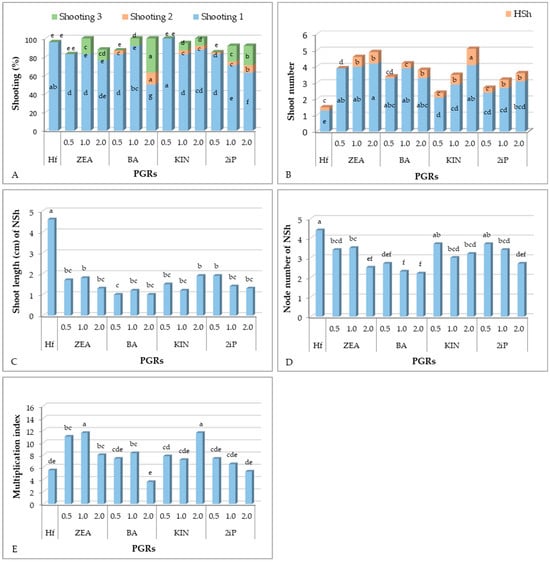
Figure 3.
Effect of cytokinin type and concentration on the response of Ballota acetabulosa single-node explants, derived from in vitro grown seedlings, at the culture establishment stage. One-way ANOVA, mean separation by Student’s t at p ≤ 0.05, n = 24. Means followed by the same letter a–f do not defer at p ≤ 0.05. Shooting1: the explants gave normal (NSh) and hyperhydric shoots (HSh). Shooting2: the explants gave hyperhydric shoots only. Shooting3: the explants gave a hyperhydric mass. Multiplication index = shooting1 (%) × shoot number of NSh × node number of NSh. The blue color in figures refers to data for normal shoots.
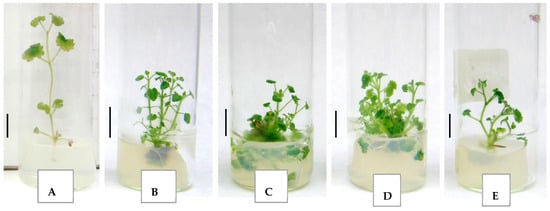
Figure 4.
Response of Ballota acetabulosa single-node explants, derived from in vitro grown seedlings, at the culture establishment stage, on Hf-MS medium (A), or MS medium supplemented with 1.0 mg L−1 ZEA (B), 2.0 mg L−1 ΒA (C), 2.0 mg L−1 KIN (D), or 2.00 mg L−1 2iP (E). Bar size: 1 cm.
3.2. Shoot Multiplication at First Subculture
In the first subculture, where both shoot-tip and single-node explants were excised from microshoots produced at the establishment stage and cultured in the same media from which the explants were derived, there were significant interactions of experimental factors, except in the case of the normal shoot number and length, which were not affected by explant type and cytokinin concentration, respectively (three-way ANOVA, Table S2 in Supplementary Materials). Thus, we proceeded to two-way ANOVA for shoot-tip and single-node explants separately, which showed significant effects of cytokinin type on shoot length and node number in both explant types (Table S3 in Supplementary Materials) and a significant effect of cytokinin concentration on node number only in single-node explants (Table S4 in Supplementary Materials).
The explant response for shoot production was similar to that of the establishment stage; however, hyperhydricity was increased and in most media was more pronounced in single-node explants (Figure 5A,B). Shoot number was highest in media with 1 mg L−1 ZEA or BA and the highest of all was observed in single-node explants in the medium with 1 mg L−1 ZEA (eight normal shoots plus two hyperhydric per explant, Figure 5C,D and Figure 6). However, shoot length and number of nodes were reduced in the presence of cytokinin, particularly in ZEA and BA (Figure 5E,F and Figure 6), where the percentage of explants producing normal shoots was also reduced due to increased hyperhydricity (Figure 5A,B), and this resulted in multiplication indices similar to those at the establishment stage, although shoot numbers per explant were higher at the subculture (Figure 3B,E and Figure 5C,D,G).

Figure 5.
Effect of explant type, cytokinin type, and cytokinin concentration on the response of Ballota acetabulosa shoot-tip or single-node explants at the first subculture. One-way ANOVA, mean separation by Student’s t at p ≤ 0.05, n = 24. Means followed by the same letter a–k do not defer at p ≤ 0.05. Shooting1: the explants gave normal (NSh) and hyperhydric shoots (HSh). Shooting2: the explants gave hyperhydric shoots only. Shooting3: the explants gave a hyperhydric mass. Multiplication index = shooting1 (%) × shoot number of NSh × node number of NSh.

Figure 6.
Response of Ballota acetabulosa shoot tip or single-node explants at the 1st subculture on Hf-MS medium (A), or MS medium supplemented with 1.0 mg L−1 ZEA (B), or ΒA (C). Bar size: 1 cm.
3.3. Effect of Continuous Subcultures on Shoot Multiplication
In four consecutive subcultures of shoot-tip or single-node explants on media either Hf or supplemented with 1 mg L−1 ZEA or BA, factorial analysis showed significant interactions between the three experimental factors, i.e., subculture number, cytokinin type, and explant type, and thus two-way ANOVAs were determined separately for shoot-tip or single-node explants, which showed an effect of PGRs on shoot length that was not affected by the subculture number when shoot-tip explants were used (Table S5 in Supplementary Materials) and an effect of both PGRs and subculture number on multiplication index in case of single-node explants (Table S6 in Supplementary Materials).
When shoot-tip explants were used, the percentage of explants that responded to shoot production remained constant in subcultures on Hf or ZEA medium, whereas it decreased on BA medium as subcultures progressed. In the case of single-node explants, as subcultures progressed, there was a decrease in explant response in all media (Figure 7A,B). Regarding hyperhydricity, in most cases, it increased as the subcultures progressed (Figure 7A,B). More shoots were produced in cytokinin media, and in these media, there was an increase in the number of shoots in the third and fourth subculture, while shoot length and number of nodes remained constant in the subcultures, being lower than in Hf medium (Figure 7C–F and Figure 8). The large increase in shoot number in the third and fourth subcultures in cytokinin media did not lead to an analogous increase in multiplication indices due to the simultaneous increase in the number of hyperhydric shoots per explant (Figure 7C,D,G and Figure 8). Thus, addressing hyperhydricity proved necessary.
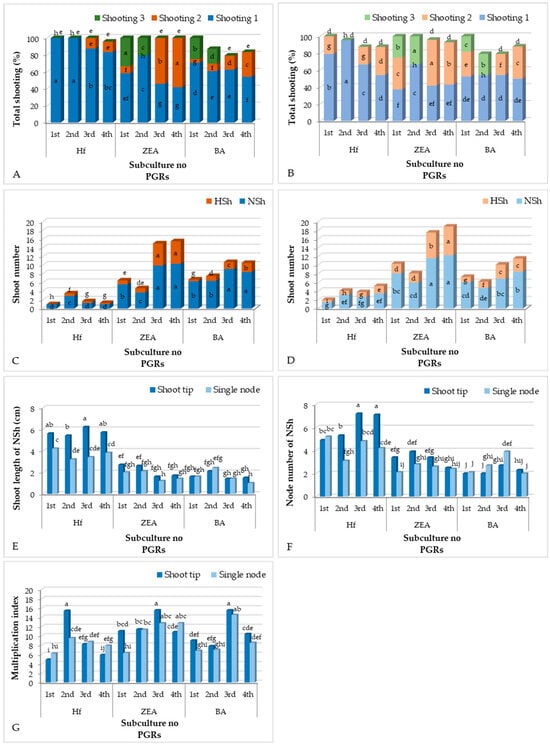
Figure 7.
Effect of BA and ZEA at 1 mg L−1 on the response of Ballota acetabulosa shoot-tip or single-node explants in continuous subcultures at the multiplication stage. One-way ANOVA, mean separation by Student’s t at p ≤ 0.05, n = 24. Means followed by the same letter a–j do not defer at p ≤ 0.05. Shooting1: the explants gave normal (NSh) and hyperhydric shoots (HSh). Shooting2: The explants gave hyperhydric shoots only. Shooting3: The explants gave a hyperhydric mass. Multiplication index = shooting1 (%) × shoot number of NSh × node number of NSh.
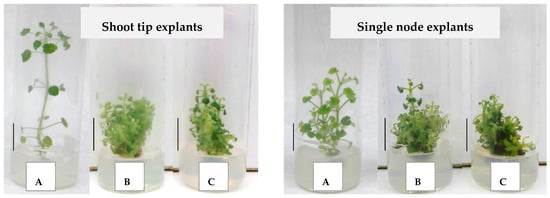
Figure 8.
Response of Ballota acetabulosa shoot tip or single-node explants at the 3rd subculture on Hf-MS medium (A), or MS medium supplemented with 1.0 mg L−1 ZEA (B) or ΒA (C). Bar size: 1 cm.
3.4. Effect of Agar Concentration on Hyperhydricity
A fifth subculture took place using shoot-tip and single-node explants mixed where MS medium was supplemented with BA at 0.5 or 1.0 mg L−1 and solidified either as usual with 0.8 g L−1 agar or with 12 g L−1 agar, while Hf-MS solidified with 0.8 g L−1 agar was also used as a control. Greatest number of shoots was produced with the 1 mg L−1 BA medium. Hyperhydricity, which was higher in BA media, was eliminated to the control level when the agar concentration was increased. Thus, media with BA and solidified with 12 mg L−1 agar gave high multiplication indices (Table 1 and Figure 9).

Table 1.
Effect of BA and agar concentration on the response of Ballota acetabulosa shoot-tip and single-node explants (mixed) in the 5th subculture.
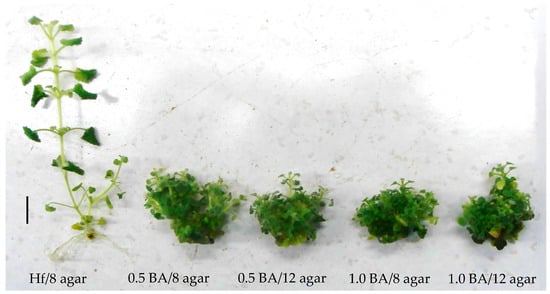
Figure 9.
Response of Ballota acetabulosa shoot-tip and single-node explants (mixed) in the 5th subculture on MS medium with BA and agar concentrations (mg L−1 and g L−1, respectively) shown. Bar size: 1 cm.
3.5. In Vitro Rooting
Apical and basal microcuttings showed 100% rooting on MS medium in all treatments even those without IBA. The addition of IBA up to 1 mg L−1 or 2.0 mg L−1 to the medium increased the number and length of roots in the apical or basal microcuttings, respectively, while at 4 mg L−1, the response was as in the control (Figure 10A,B). Concurrent with rooting, axillary bud sprouting was observed in IBA media, which was more pronounced in basal microcuttings and high IBA concentrations (Figure 11).

Figure 10.
Effect of IBA concentration and microcutting type on root number (A) and root length (B) during in vitro rooting of B. acetabulosa on MS medium (rooting response 100% in all treatments). Mean separation in each figure by Student’s t, p ≤ 0.05. Means followed by the same letter a–d do not defer at p ≤ 0.05. NS or **, ***: non-significant at p ≤ 0.05 or significant at p ≤ 0.01, p ≤ 0.001, respectively; n = 60.
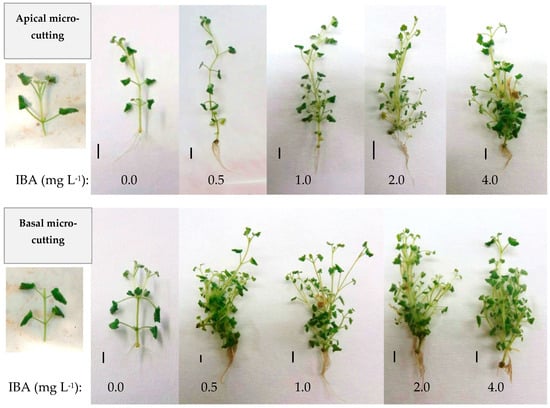
Figure 11.
In vitro rooting of apical or basal microcuttings of B. acetabulosa on MS medium under the effect of IBA concentrations shown. Bar size: 1.0 cm.
Microshoot clusters, like the microcuttings, rooted 100% in all treatments, showing an increase in the number of roots produced per cluster proportional to the increase in IBA concentration, up to the highest IBA concentration tested, i.e., 4 mg L−1 (Figure 12A). Regarding root length, it was highest at 0.5 mg L−1 IBA and lowest at 2.0 and 4.0 mg L−1 IBA (Figure 12B). At the same time, elongation of the microshoots was observed in all media, with the greatest elongation occurring in some of the microshoots in the Hf medium (Figure 13).
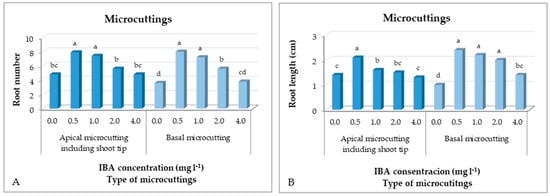
Figure 12.
Effect of IBA concentration on root number (A) and root length (B) during in vitro rooting of B. acetabulosa microshoot clusters on half-strength MS medium (rooting response 100% in all treatments). Mean separation in each figure by Student’s t, p ≤ 0.05. Means followed by the same letter a–d do not defer at p ≤ 0.05. Fone-way ANOVA significant at p ≤ 0.001, n = 40.

Figure 13.
In vitro rooting of B. acetabulosa microshoot clusters on half-strength MS medium under the effect of IBA concentration shown. Bar size = 1.0 cm.
3.6. Ex Vitro Acclimatization
Rooted microcuttings of both types, apical and basal, and rooted clusters of microshoots were acclimatized ex vitro at 100%, maintaining the characteristics of the mother plants. Further plant growth for the next three months after transplanting was 100% successful (Figure 14A,B).
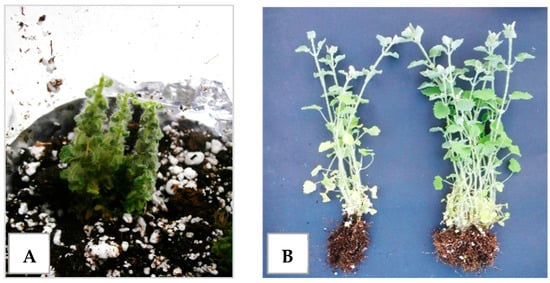
Figure 14.
Rooted B. acetabulosa microshoot cluster transplanted on peat/perlite (1:1, v/v) for acclimatization (A) and rooted microshoot clusters three months after their ex vitro transplantation (B).
4. Discussion
4.1. In Vitro Culture Establishment
The floriculture and landscape plant industry is constantly looking for new products to introduce to markets. In addition, the climate crisis is a new parameter that forces the investigation of new species with tolerance to harsh environments so that they can withstand and show satisfactory growth in xerothermic conditions, water scarcity, sudden changes in environmental conditions, or increased urban pollution [28,29]. In arid and semi-arid regions, research on indigenous species with tolerance to heat and drought and the ability to grow with minimal water supply is very important in order to introduce them into horticulture and landscape architecture, as water is a precious commodity and must to be provided sparingly in urban greenery [30,31,32,33].
B. acetabulosa is a promising for xeriscaping native plant of Greece and western Turkey [1,2], and an efficient micropropagation protocol will be useful in its commercial production process. Further, given its medicinal properties [10,13], in vitro propagation will facilitate the isolation of clones with desirable characteristics.
The establishment of in vitro cultures from seedlings developed in vitro ensures sterile mother material, overcoming the obstacle of surface sterilization of the explants, which in the case of plants with woolly tissues such as B. acetabulosa is rather difficult [34,35]. Moreover, explants from young in vitro seedlings often respond more readily to in vitro culture compared to similar explants from adult plants [24,36]. In addition, this can lead to the production of clones with special characteristics, while the variability of cultures ensures a level of diversity that is desirable in the use of plants in landscape restoration. To the best of our knowledge, there is no documentation in the literature on the micropropagation of B. acetabulosa, apart from a preliminary publication by us [14].
In the present work, the initial establishment of cultures from in vitro grown seedlings was easy and successful. Ballota acetabulosa is an open-pollinated species; thus, even seeds from the same plant could have genetic variability. However, no variability was recorded in terms of in vitro seedling growth and the response of seedling explants in the following experiments, e.g., in the Hf-control medium at the culture establishment stage, the seedling explants showed 98% response and formed 1–2 shoots each. Nodal explants reacted at rates higher than 80% even in Hf-MS medium, where they gave 1–2 shoots per explant, while the addition of all four cytokinin types tested induced a sufficient number of shoots per explant with satisfactory elongation, distinguishing ZEA and BA at a concentration of 1 mg L−1, where approximately 4 shoots were formed per explant. Similarly, highly successful establishment of in vitro cultures from aseptically germinated seedlings has been shown in other xerophytic species of the family Lamiaceae, such as the Mediterranean Salvia spp.: S. fruticosa, S. officinalis, S. ringens, and S. pomifera ssp. pomifera [25], Teuctium capitatum [22] and Sideritis athoa [37], as well as Mediterranean xerophytes of other families, e.g., Dianthus fruticosus [38] and D. cruentus of f. Caryophyllaceae [23,39], Lithodora zahnii f. Boraginaceae [40], and Anthyllis hermanniae and Ebenus sibthorpii f. Fabaceae [24,41]; however, there are exceptions, such as, e.g., Lamiaceae S. tomentosa, which did not show high establishment rates from aseptically germinated seedlings compared to greenhouse-grown adult plants [35]. Micropropagation of native species using explants from sterile juvenile tissues, in addition to ensuring a lack of microbial contaminants, increases response rates and the absence of recalcitrance, offering genetic variability that is desirable when the plants will be used for landscape restoration, as in nature, the introduction of a single clone is not desirable [42]. Thus, in vitro culture of pre-existing apical or nodal meristems is the most reliable and widely used method for micropropagation of many species, including medicinal and aromatic plants [43].
4.2. Multiplication Stage and Addressing Hyperhydricity
In the first subculture, which was carried out on substrates identical to those of the initial culture, in addition to single-node explants, shoot-tip explants were also used. The response percentage of the explants to produce normal shoots was reduced as the hyperhydricity percentage of the explants intensified compared to the initial culture; however, the number of shoots per explant increased, and at 1 mg L−1 ZEA or BA, it reached 5.5 or 6 in the shoot-tip explants and 7.8 or 6.8 in the single-node explants, respectively, while the microshoots produced showed greater elongation compared to the initial culture. In the third and fourth subculture in 1 mg L−1 ZEA or BA, the number of normal shoots increased to 9–11 per explant in ZEA and 6–8 in BA, while the hyperhydric shoots also increased up to 4 or 6 per explant in BA and ZEA, respectively. The increased number of shoots as well as the hyperhydricity in successive subcultures on the same medium may be due to a cytokinin accumulation effect in plant tissues. In the four consecutive subcultures, both types of explant responded in a rather similar manner, except that hyperhydricity in most cases was more pronounced in single-node explants compared to shoot tip ones, verifying previous results concerning Mediterranean Salvia spp. [25,35]. Increased numbers of shoots in a subculture carried out on the same media as those of the establishment stage were also shown in the Mediterranean xerophytes A. hermaniae [24], Salvia spp. [25], and L. monopetalum [44], while in others such as D. cruentus [23], E. sibthorpii [41], and Clinopodium nepeta [36], shoot proliferation in the subculture remained rather constant.
In tissue cultures of herbaceous plants and especially in cultures derived from seedlings, the problem of hyperhydricity is often encountered, mainly at the stage where increased concentrations of cytokinins are used to induce high shoot proliferation, thus negatively affecting growth quality and causing significant loss of plant material. Hyperhydricity has been reported in micropropagation using seedlings as parent material in several Mediterranean xerophytes, e.g., Globularia alypum [45], Lithodora zahnii [40], Sideritis athoa [37], Anthyllis barbajovis [46], Salvia tomentosa [35], and Dianthus cruentus [23]. As mentioned above, hyperhydricity in general was more pronounced in single-node explants compared to shoot tip ones, verifying previous results with other Mediterranean xerophytic species [25,35]. The different endogenous hormonal statuses of the shoot-tip and single-node explants combined with the exogenous effect of the substrate cytokinin probably caused different intensities of hyperhydration. Alternatively, or simultaneously, the presence of the shoot tip in the explants may have affected the absorption of substrate components and water in a different way than in the nodal explants. Hyperhydricity can be due to various factors, such as genotypic sensitivity, reduced aeration of cultures and ethylene accumulation in the culture vessels [20,47,48], nitrate and ammonium composition in the culture medium [19,47,49], type and amount of cytokinin [18,19,48,50,51], and cytokinin/auxin balance in the medium [36,52,53]. Taking into account these factors, which contribute to the complexity of the phenomenon of hyperhydricity, addressing hyperhydricity must be species-specific [51].
In the present study, increasing agar concentration eliminated hyperhydricity without negatively affecting shoot proliferation indices. On the contrary, the multiplication index increased. These findings verified similar results regarding the treatment of hyperhydricity by increasing agar concentration in the micropropagation of other Mediterranean species, e.g., the xerophytes Lithodora zahnii [40], Globularia alypum [45], C. nepeta [36], Calamintha cretica [52], and Dianthus cruentus [23], as well as other herbaceous species [54,55]. Modifying the type and concentration of the solidifying agent in the medium regulates the water potential, the diffusion of micronutrients, and the uptake of cytokinins by the explants [56].
4.3. In Vitro Rooting
Rooting of in vitro-produced microshoots is a very important stage in micropropagation. The goal is rapid rhizogenesis and elongation of the roots in order to achieve a strong and rich root system that will subsequently ensure successful acclimatization to ex vitro conditions. The most common procedure is to place the tops of microshoots 1–3 cm long in half-strength MS medium containing some amount of auxin, usually IBA. In our work, rooting of microcuttings in MS medium was completely successful, even without the use of auxin; however, the addition of auxin induced more and longer roots. The use of seedlings as mother plants for in vitro cultures establishment probably facilitated in vitro response. The ease of rooting confirms the generally accepted fact that juvenile tissues are most responsive in culture compared to mature tissues [57,58]. It is noteworthy that microcuttings from the basal part of the microshoots rooted equally successfully to apical microcuttings that included the tip of the shoot, the latter being the standard procedure for in vitro rooting. The basal microcuttings produced roots with shoots simultaneously. This is a positive finding because the entire length of a long microshoot can be used for producing more than one plantlet. Placing single-node pieces of a microshoot for rooting results in more rooted plantlets per microshoot, and in this way, costs in commercial production could be reduced. To our knowledge, in vitro rooting of stem pieces, without apical meristem, with simultaneous shoot production is reported for the first time in the international literature.
Rooting at high rates in auxin-free MS medium has also been demonstrated in other perennial Mediterranean shrubs and herbs, such as A. barba-jovis [46], L. monopetalum [44], Thymus satureioides [59], Lavandula officinalis [60], C. nepeta [36], C. cretica [52], Origanum scabrum [61], O. ehrenbergii and O. syriacum [62], and S. officinalis and S. tomentosa [25], while others such as T. capitatum [22], Lithodora zahnii [40], and S. fruticosa and S. ringens [25] required the presence of auxin to exhibit high rooting rates. Further, other Mediterranean xerophytic shrubs such as A. hermanniae [24], S. athoa [37], G. alypum [45], E. sibthorpii [41], and Thymelaea tartonraira spp. tartonraira [63] rooted at low rates in vitro, while T. hirsuta failed to root [64,65], confirming the importance of the genome in the in vitro response.
In the present work, the addition of IBA to the medium at 1.0–2.0 mg L−1 or 0.5–2.0 mg L−1 when shoot-tip or single-node microcuttings, respectively, were placed for rooting, in addition to increasing the number and length of roots, induced intense sprouting of axillary shoots, producing a branched plantlet that did not require pruning after its ex vitro establishment to obtain a marketable shape. Sprouting of axillary shoots during the rooting stage when increased IBA concentration was used, but to a much lesser extent, was found in A. hermaniae [24] and C. cretica [52].
Microshoot clusters, like microcuttings, rooted 100% in all treatments, including the one without IBA, showing an increase in the number of roots produced per cluster proportional to the increase in IBA concentration, up to the highest IBA concentration tested, i.e., 4 mg L−1, in contrast to microcuttings, which at the highest IBA concentrations showed a reduction in the number of roots. Regarding root length, it was highest at the lowest IBA concentration and decreased slightly, proportionally, with increasing IBA concentration. A negative relation between root number and root length has been shown also in other Mediterranean xerophytes such as T. capitatum [22], L. monopetalum [44], D. cruentus [23], S. ringens, and S. tomentosa [25]. This could be attributed to the fact that in substrates with higher IBA concentration, we had continuous root production and therefore roots formed close to the date of data collection had a shorter length, thus negatively affecting the average length of roots per microcutting. Alternatively, a higher auxin concentration in the initial stage of rooting favors root induction, but subsequently, in the stage of root elongation, it is an inhibitory factor [22,66].
4.4. Ex Vitro Acclimatization
Ex vitro acclimatization is the final but often most hazardous step in a micropropagation system, as plantlets have to correct abnormal morphology, anatomy, and physiology imposed by in vitro conditions [67]. B. acetabulosa plantlets produced by rooting either apical or basal microcuttings, as well as microshoot clusters, were acclimatized and established ex vitro at 100%, presenting morphological characteristics similar to the mother plants. Similarly, the Mediterranean xerophytic shrubs A. hermaniae [24], A. barba-jovis [67], L. monopetalum [44], and T. capitatum [22] have been shown to acclimatize at 100% ex vitro, while Salvia spp. [25], C. cretica [52], C. nepeta [36], and D. fruticosus [38] also acclimatized at quite high rates, reaching 70–100%. On the contrary, the acclimatization of others, such as G. alypum, was very low [45] or failed completely, as in E. sibthorpii [41].
5. Conclusions
In this study, B. acetabulosa, the Greek horehound, was successfully micropropagated using shoot-tip and single-node explants derived from in vitro-grown seedlings. Both at the establishment stage of the culture and the five subcultures that took place, the explants responded at very high percentages, producing high numbers of shoots on solid MS medium supplemented with 1.0 mg L−1 ZEA or BA. The agar concentration is recommended to be increased to 12 g L−1 in order to address hyperhydricity problems while maintaining high proliferation indices (92% explant response, 10.2 shoots per explant).
Microcuttings from either the apical part, including the apical meristem, or the basal part of the microshoots, as well as microshoot clusters, rooted 100% on full- or half-strength MS medium, respectively, even in the absence of auxin in the medium. However, the addition of ΙΒA at 1 mg L−1 to the rooting medium is recommended, as it induces a greater number of roots and longer roots, as well sprouting of a number of axillary buds in the microcuttings, leading to a suitable plant shape for the floricultural market, without the need for further pruning in the nursery. To our knowledge, this is the first report of the use of microcuttings without the shoot tip for rooting and in vitro plant production.
Plantlets were acclimatized to 100% in ex vitro conditions in 1:1 (v/v) peat/perlite substrate.
Thus, efficient micropropagation protocols for B. acetabulosa were developed that allow for further exploitation of the species in the floricultural and pharmaceutical industries. In particular, its use as a landscape plant for arid and semi-arid areas is fully in line with the requirement to enhance vegetation with species that have low water needs, which is becoming even more intense due to the climate crisis we are facing.
Supplementary Materials
The following supporting information can be downloaded at: https://www.mdpi.com/article/10.3390/horticulturae11040390/s1, Table S1: Εffect of the experimental factors, i.e., cytokinin type (ZEA, BA, KIN, 2iP) and concentration (0.5, 1.0, 2.0 mg L−1) on the response of Ballota acetabulosa single-node explants at the establishment stage; Table S2: Effect of the experimental factors, i.e., explant type (shoot tip, single node), cytokinin type (ZEA, BA, KIN, 2iP) and concentration (0.5, 1.0, 2.0 mg L−1) on the response of Ballota acetabulosa explants at the first subculture; Table S3: First subculture: effect of the experimental factors, i.e., cytokinin type (ZEA, BA, KIN, 2iP) and concentration (0.5, 1.0, 2.0 mg L−1) on the response of Ballota acetabulosa shoot-tip explants derived from microshoots produced at the establishement stage; Table S4: Effect of the experimental factors, i.e., cytokinin type (ZEA, BA, KIN, 2iP) and concentration (0.5, 1.0, 2.0 mg L−1) on the response of Ballota acetabulosa single-node explants at the first subculture; Table S5: Effect of the experimental factors, i.e., subculture number (1st, 2nd, 3rd, 4th) and cytokinin type (ZEA, BA) at 1 mg L−1 on the response of Ballota acetabulosa shoot-tip explants at the multiplication stage; Table S6: Effect of the experimental factors, i.e., subculture number (1st, 2nd, 3rd, 4th) and cytokinin type (ZEA, BA) at 1 mg L−1 on the response of Ballota acetabulosa single-node explants at the multiplication stage.
Author Contributions
Conceptualization, M.P. and G.V.; methodology, G.V. and M.P.; validation, M.P. and G.V.; investigation, G.V. and M.P.; resources, M.P.; data curation, G.V.; writing—original draft preparation, G.V. and M.P.; writing—review and editing, M.P. and G.V.; visualization, G.V.; supervision, M.P.; project administration, M.P.; funding acquisition, M.P. All authors have read and agreed to the published version of the manuscript.
Funding
This research was co-financed by the European Regional Development Fund of the European Union and Greek national funds through the Operational Program Education and Lifelong Learning, NRSF 2007-2013. (Project code: MIS 380237; Project: Thalis-ARCHEOSCAPE).
Data Availability Statement
The original contributions presented in this study are included in the article/Supplementary Material. Further inquiries can be directed to the corresponding author.
Conflicts of Interest
The authors declare no conflicts of interest. The funders had no role in the design of the study; in the collection, analyses, or interpretation of data; in the writing of the manuscript, or in the decision to publish the results.
References
- Dimopoulos, P.; Raus, T.; Bergmeier, E.; Constantinidis, T.; Iatrou, G.; Kokkini, S.; Strid, S.; Tzanoudakis, D. Vascular Plants of Greece: An Annotated Checklist; Botanischer Garten und Botanisches Museum Berlin-Dahlem; Hellenic Botanical Society: Berlin, Germany, 2013; p. 106. [Google Scholar]
- Davis, P.H. Flora of Turkey and the East Aegean Islands; Edinburgh University, Edinburgh Press: Edinburgh, UK, 1982; Volume 7, pp. 156–160. [Google Scholar]
- Huxley, A.; Taylor, W. Flowers of Greece and the Aegean; Chatto & Windus: London, UK, 1977. [Google Scholar]
- Psaras, G.K.; Rhizopoulou, S. Mesophyll structure during leaf development in Ballota acetabulosa. New Phytol. 1995, 131, 303–309. [Google Scholar] [CrossRef]
- Sahpaz, S.; Skaltsounis, A.L.; Bailleul, F. Polyphenols from Ballota acetabulosa. Biochem. Syst. Ecol. 2002, 30, 601–604. [Google Scholar] [CrossRef]
- Petanidou, T.; Vokou, D. Pollination Ecology of Labiatae in a Phryganic (East Mediterranean) Ecosystem. Am. J. Bot. 1993, 80, 892–899. [Google Scholar] [CrossRef]
- Mulas, M. Traditional Uses of Labiatae in the Mediterranean Area. Acta Hortic. 2006, 723, 25–32. [Google Scholar] [CrossRef]
- Dulger, B.; Sener, A. Evaluation of antimicrobial activity of Ballota acetabulosa. Afr. J. Microbiol. Res. 2010, 4, 1235–1238. [Google Scholar]
- Newall, C.A.; Anderson, L.A.; Philipson, J.D. Herbal Medicines, a Guide for Health-Care Professionals; The Pharmaceutical Press: London, UK, 1996; pp. 164–172. [Google Scholar]
- Citoglu, G.; Tanker, M.; Sever, B.; Englert, J.; Anton, R.; Altanlar, N. Antibacterial activities of diterpenoids isolated from Ballota saxatilis subsp. saxatilis. Planta Med. 1998, 64, 484–485. [Google Scholar] [CrossRef]
- Couladis, M.; Tzakou, O.; Verykokidou, E.; Harvala, C. Screening of some Greek aromatic plants for antioxidant activity. Phytother. Res. 2003, 17, 194–195. [Google Scholar] [CrossRef] [PubMed]
- Papafotiou, M.; Bertsouklis, K.; Martini, A.N.; Vlachou, G.; Akoumianaki-Ioannidou, A.; Kanellou, E.; Kartsonas, E. Evaluation of the establishment of native Mediterranean plant species suggested for landscape enhancement in archaeological sites of Greece. Acta Hortic. 2017, 1189, 177–180. [Google Scholar] [CrossRef]
- Egerer, M.; Cecala, J.; Cohen, H. Wild Bee Conservation within Urban Gardens and Nurseries: Effects of Local and Landscape Management. Sustainability 2019, 12, 293. [Google Scholar] [CrossRef]
- Vlachou, G.; Papafotiou, M.; Bertsouklis, K.F. In Vitro Propagation of Ballota acetabulosa. Acta Hortic. 2016, 1113, 171–174. [Google Scholar] [CrossRef]
- Chakrabarty, D.; Park, S.Y.; Ali, M.B.; Shin, K.S.; Paek, K.Y. Hyperhydricity in apple: Ultrastuctural and physiological aspects. Tree Physiol. 2006, 26, 377–388. [Google Scholar] [CrossRef] [PubMed]
- Ziv, M. Vitrification: Morphological and physiological disorders of in vitro plants. In Micropropagation: Technology and Application; Debergh, P.C., Zimmerman, R.H., Eds.; Kluwer Academic Publishers: Dordrecht, The Netherlands, 1991; pp. 45–69. [Google Scholar] [CrossRef]
- Hazarika, B.N. Review. Morpho-physiological disorders in in vitro culture of plants. Sci. Hortic. 2006, 108, 105–120. [Google Scholar] [CrossRef]
- Ivanova, M.; Van Staden, J. Influence of gelling agent and cytokinins on the control of hyperhydricity in Aloe polyphylla. Plant Cell Tissue Organ Cult. 2011, 104, 13–21. [Google Scholar] [CrossRef]
- Ivanova, M.; Van Staden, J. Effect of ammonium ions and cytokinins on hyperhydricity and multiplication rate of in vitro regenerated shoots of Aloe polyphylla. Plant Cell Tissue Organ Cult. 2008, 92, 227–231. [Google Scholar] [CrossRef]
- Ivanova, M.; Van Staden, J. Natural ventilation effectively reduces hyperhydricity in shoot cultures of Aloe polyphylla Schönland ex Pillans. Plant Growth Regul. 2010, 60, 143–150. [Google Scholar] [CrossRef]
- Papafotiou, M.; Bertsouklis, K.F.; Trigka, M. Micropropagation of Arbutus unedo, A. andrachne, and their natural hybrid, A. x andrachnoides from seedling explants. J. Hortic. Sci. Biotechnol. 2013, 88, 768–775. [Google Scholar] [CrossRef]
- Papafotiou, M.; Martini, A.N. In vitro seed and clonal propagation of the Mediterranean aromatic and medicinal plant Teucrium capitatum. HortScience 2016, 51, 403–411. [Google Scholar] [CrossRef]
- Bazanis, A.E.; Papafotiou, M. In Vitro Germination, Micropropagation and Addressing the Hyperhydricity of the Balkan Native Dianthus cruentus, a Plant with High Ornamental and Xeriscaping Potential. Horticulturae 2024, 10, 813. [Google Scholar] [CrossRef]
- Martini, A.N.; Papafotiou, M. In Vitro Seed and Clonal Propagation of the Mediterranean Bee Friendly Plant Anthyllis hermanniae L. Sustainability 2023, 15, 4025. [Google Scholar] [CrossRef]
- Papafotiou, M.; Vlachou, G.; Martini, A.N. Investigation of the Effects of the Explant Type and Different Plant Growth Regulators on Micropropagation of Five Mediterranean Salvia spp. Native to Greece. Horticulturae 2023, 9, 96. [Google Scholar] [CrossRef]
- Sarasan, V.; Kite, G.C.; Sileshi, G.W.; Stevenson, P.C. Applications of phytochemical and in vitro techniques for reducing over-harvesting of medicinal and pesticidal plants and generating income for the rural poor. Plant Cell Rep. 2011, 30, 1163–1172. [Google Scholar] [CrossRef] [PubMed]
- Murashige, T.; Skoog, F. A revised medium for rapid growth and bioassays with tobacco tissue cultures. Physiol. Plant. 1962, 15, 473–497. [Google Scholar] [CrossRef]
- Çetin, N.; Mansuroğlu, S.; Önaç, A.K. Xeriscaping Feasibility as an Urban Adaptation Method for Global Warming: A Case Study from Turkey. Pol. J. Environ. Stud. 2018, 27, 1009–1018. [Google Scholar] [CrossRef]
- Caneva, G.; Kumbaric, A.; Savo, V.; Casalini, R. Ecological Approach in Selecting Extensive Green Roof Plants: A Data-Set of Mediterranean Plants. Plant Biosyst. 2013, 149, 374–383. [Google Scholar] [CrossRef]
- Ondoño, S.; Martínez-Sánchez, J.J.; Moreno, J.L. Evaluating the growth of several Mediterranean endemic species in artificial substrates: Are these species suitable for their future use in green roofs? Ecol. Eng. 2015, 81, 405–417. [Google Scholar] [CrossRef]
- Papafotiou, M.; Martini, A.N.; Tassoula, L.; Stylias, E.G.; Kalantzis, A.; Dariotis, E. Acclimatization of Mediterranean Native Sages (Salvia spp.) and Interspecific Hybrids in an Urban Green Roof under Regular and Reduced Irrigation. Sustainability 2022, 14, 4978. [Google Scholar] [CrossRef]
- Azeñas, V.; Janner, I.; Medrano, H.; Gulías, J. Performance Evaluation of Five Mediterranean Species to Optimize Ecosystem Services of Green Roofs under Water-Limited Conditions. J. Environ. Manag. 2018, 212, 236–247. [Google Scholar] [CrossRef]
- Tassoula, L.; Papafotiou, M.; Liakopoulos, G.; Kargas, G. Water use efficiency, growth and anatomic-physiological parameters of Mediterranean xerophytes as affected by substrate and irrigation on a green roof. Not. Bot. Hortic. Agrobot. Cluj-Napoca 2021, 49, 12283. [Google Scholar] [CrossRef]
- Kumar, M.; Prasad, Y.; Yadav, A.; Kumar, A. Effects of two different surface sterilization (Sodium Hypochlorite and Mercuric Chloride) agents under in-vitro leaf explant in Gerbera (Gerbera jamesonii Bolus). J. Pharm. Innov. 2021, 10, 1346–1349. Available online: https://www.researchgate.net/publication/361902680 (accessed on 20 January 2025).
- Martini, A.N.; Vlachou, G.; Papafotiou, M. Effect of Explant Origin and Medium Plant Growth Regulators on In Vitro Shoot Proliferation and Rooting of Salvia tomentosa, a Native Sage of the Northeastern Mediterranean Basin. Agronomy 2022, 12, 1889. [Google Scholar] [CrossRef]
- Vlachou, G.; Papafotiou, M.; Bertsouklis, K.F. Studies on Seed Germination and Micropropagation of Clinopodium nepeta: A Medicinal and Aromatic Plant. HortScience 2019, 54, 1558–1564. [Google Scholar] [CrossRef]
- Papafotiou, M.; Kalantzis, A. Seed germination and in vitro propagation of Sideritis athoa. Acta Hortic. 2009, 813, 471–476. [Google Scholar] [CrossRef]
- Papafotiou, M.; Stragas, J. Seed Germination and in Vitro Propagation of Dianthus fruticosus. Acta Hortic. 2009, 813, 481–484. [Google Scholar] [CrossRef]
- Ivanovic, S.; Markovic, M.; Milutinovic, M.; Skocajic, D.; Dunisijevic-Bojovic, D. In Vitro Propagation of Dianthus cruentus and Acclimatization in Hydroponic Culture. Phyton 2023, 62–63, 107–114. [Google Scholar]
- Papafotiou, M.; Kalantzis, A. Studies on in vitro propagation of Lithodora zahnii. Acta Hortic. 2009, 813, 465–470. [Google Scholar] [CrossRef]
- Bertsouklis, K.F.; Vazaka-Vodena, D.; Bazanis, A.E.; Papafotiou, M. Studies on Seed Germination and Micropropagation of Ebenus sibthorpii, an Endemic Shrub of Greece with Potential Ornamental Use. Horticulturae 2023, 9, 1300. [Google Scholar] [CrossRef]
- Máthé, A.; Hassan, F.; Abdul Kader, A. In vitro micropropagation of medicinal and aromatic plants. In Medicinal and Aromatic Plants of the World; Máthé, A., Ed.; Springer Science+Business Media: Dordrecht, The Netherlands, 2015; Volume 1, pp. 305–336. [Google Scholar] [CrossRef]
- Martini, A.N.; Papafotiou, M. In Vitro Propagation and NaCl Tolerance of the Multipurpose Medicinal Halophyte Limoniastrum monopetalum. HortScience 2020, 55, 436–443. [Google Scholar] [CrossRef]
- Bertsouklis, K.; Papafotiou, M.; Balotis, G. Effect of medium on in vitro growth and ex vitro establishment of Globularia alypum. Acta Hortic. 2003, 616, 177–180. [Google Scholar] [CrossRef]
- Trigka, M.; Papafotiou, M. In Vitro Propagation of Anthyllis barba-Jovis from Seedling Tissues. Acta Hortic. 2017, 1189, 473–748. [Google Scholar] [CrossRef]
- Sreelekshmi, R.; Siril, E.A.; Muthukrishnan, S. Role of Biogenic Silver Nanoparticles on Hyperhydricity Reversion in Dianthus chinensis L. An in Vitro Model Culture. J. Plant Growth Regul. 2021, 41, 23–39. [Google Scholar] [CrossRef]
- Mohamed, S.M.; El-Mahrouk, M.E.; El-Banna, A.N.; Hafez, Y.M.; El-Ramady, H.; Abdalla, N.; Dobránszki, J. Optimizing Medium Composition and Environmental Culture Condition Enhances Antioxidant Enzymes, Recovers Gypsophila paniculata L. Hyperhydric Shoots and Improves Rooting In Vitro. Plants 2023, 12, 306. [Google Scholar] [CrossRef] [PubMed]
- Ivanova, M.; Van Staden, J. Nitrogen source, concentration, and NH4+:NO3− ratio influence shoot regeneration and hyperhydricity in tissue cultured Aloe polyphylla. Plant Cell Tissue Organ Cult. 2009, 99, 167–174. [Google Scholar] [CrossRef]
- Ravanfar, S.A.; Salim, S.; Aziz, M.A.; Abdullah, S.N.A.; Rashid, A.A. Influence of phenyl-urea and adenine-type cytokinins on direct adventitious shoot regeneration of cabbage (Brassica oleracea subsp. capitata) “KCross”. Plant Biotechnol. 2014, 31, 275–280. [Google Scholar] [CrossRef][Green Version]
- Polivanova, O.B.; Bedarev, V.A. Hyperhydricity in Plant Tissue Culture. Plants 2022, 11, 3313. [Google Scholar] [CrossRef] [PubMed]
- Vlachou, G.; Papafotiou, M.; Bertsouklis, K. Seed germination, micropropagation from adult and juvenile origin explants and address of hyperhydricity of the Cretan endemic herb Calamintha cretica. Not. Bot. Horti Agrobot. Cluj-Napoca 2020, 48, 1504–1518. [Google Scholar] [CrossRef]
- Zunazri, N.H.; Kemat, N.; Ariffin, N.; Rineksane, I.A. Effect of media components on hyperhydricity in horticultural crops: A review. J. Plant Biotechnol. 2024, 51, 307–319. [Google Scholar] [CrossRef]
- Casanova, E.; Moysset, L.; Trillas, M.I. Effects of Agar Concentration and Vessel Closure on the Organogenesis and Hyperhydricity of Adventitious Carnation Shoots. Biol. Plant. 2008, 52, 1–8. [Google Scholar] [CrossRef]
- Gerszberg, A. Tissue Culture and Genetic Transformation of Cabbage (Brassica oleracea var. capitata): An Overview. Planta 2018, 248, 1037–1048. [Google Scholar] [CrossRef]
- Debergh, P.; Aitken-Christie, J.; Cohen, D.; Grout, B.; von Arnold, S.; Zimmerman, R.; Ziv, M. Reconsideration of the term vitrification as used in micropropagation. Plant Cell Tissue Organ Cult. 1992, 30, 135–140. [Google Scholar] [CrossRef]
- Monteuuis, O. In vitro rooting of juvenile and mature Acacia mangium microcuttings with reference to leaf morphology as a phase change marker. Trees 2004, 18, 77–82. [Google Scholar] [CrossRef]
- Preece, J. Stock Plant Physiological Factors Affecting Growth and Morphogenesis. In Plant Propagation by Tissue Culture: Volume 1. The Background, 3rd ed.; Edwin, F.G., Michael, A.H., de Klerk, G.-J., Eds.; Springer: Dordrecht, The Netherlands, 2008; pp. 403–422. [Google Scholar]
- Aicha, N.; Rachida, T.C.; El Abdelmalek, M. Micropropagation of Thymus satureioides Coss. an endangered medicinal plant of Morocco. J. Agric. Technol. 2013, 9, 487–501. [Google Scholar]
- Tyub, S.; Kamili, A.N.; Shah, A.M. Effect of BAP on Shoot Regeneration in Shoot Tip Cultures of Lavandula officinalis. J. Res. Dev. 2007, 7, 125–130. [Google Scholar]
- Alexopoulos, A.A.; Kartsonas, E.; Karras, S.; Mavrommati, E.; Petropoulos, S.A.; Papafotiou, M. In Vitro Propagation of Origanum scabrum (Boiss. & Heldr.): An Endemic Medicinal Plant of Greece. Plants 2023, 12, 2118. [Google Scholar] [CrossRef]
- El Beyrouthy, M.; Elian, G.; Abou Jaoudeh, C.; Chalak, L. In vitro propagation of Origanum syriacum and Origanum ehrenbergii. Acta Hortic. 2015, 1083, 169–172. [Google Scholar] [CrossRef]
- Martini, A.N.; Papafotiou, M. Effect of cytokinins on in vitro blastogenesis of Thymelaea tartonraira ssp. tartonraira (L.) All. Acta Hortic. 2019, 1242, 511–514. [Google Scholar] [CrossRef]
- Papafotiou, M. In vitro propagation of temperate zone woody plants with potential ornamental use. Acta Hortic. 2010, 885, 255–262. [Google Scholar] [CrossRef]
- Martini, A.N.; Papafotiou, M. Investigation of micropropagation of the Mediterranean xerophyte Thymelaea hirsuta (L.) Endl. (Thymelaeaceae). Acta Hortic. 2020, 1298, 335–340. [Google Scholar] [CrossRef]
- De Klerk, G.J.; Der Krieken, W.V.; De Jong, J.C. Review the formation of adventitious roots: New concepts, new possibilities. Vitr. Cell. Dev. Biol. Plant 1999, 35, 189–199. [Google Scholar] [CrossRef]
- Pospíšilová, J.; Tichá, I.; Kadleček, P.; Haisel, D.; Plzáková, Š. Acclimatization of micropropagated plants to ex vitro conditions. Biol. Plant. 1999, 42, 481–497. [Google Scholar]
- Vlachou, G.; Papafotiou, M.; Bertsouklis, K.F. Studies on in vitro propagation of Anthyllis barba-jovis L. Acta Hortic. 2017, 1155, 317–320. [Google Scholar] [CrossRef]
Disclaimer/Publisher’s Note: The statements, opinions and data contained in all publications are solely those of the individual author(s) and contributor(s) and not of MDPI and/or the editor(s). MDPI and/or the editor(s) disclaim responsibility for any injury to people or property resulting from any ideas, methods, instructions or products referred to in the content. |
© 2025 by the authors. Licensee MDPI, Basel, Switzerland. This article is an open access article distributed under the terms and conditions of the Creative Commons Attribution (CC BY) license (https://creativecommons.org/licenses/by/4.0/).